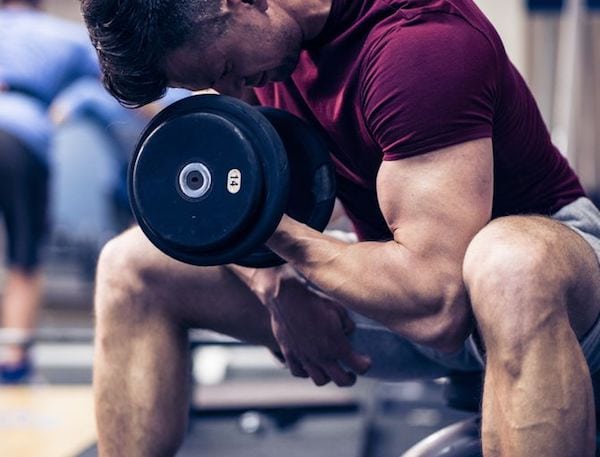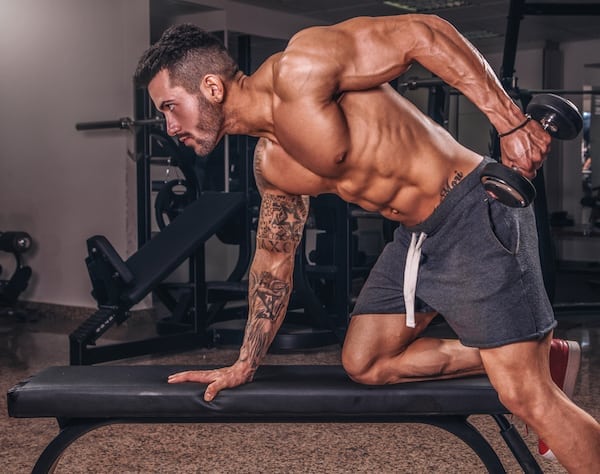No products in the cart.
Which Muscle Groups Grow the Fastest?

One thing that a lot of people in the gym struggle with is training all of their muscles equally, we all have our favourite exercises and even our favourite muscle groups. But this can lead to disastrous results if kept unchecked.
Anyone who has heard the phrase “Skipped leg day” will understand what this means.
What if we trained each muscle group for the exact same amount of time, and exposed them to the same (relative) volume? Out of these muscles which one would grow the fastest?
This is a very interesting question and the truth is that there isn’t a cut and dry answer here.
Think about it, have you ever seen two people who train with each other who look identical? It’s unlikely.
Two guys could lift the same weights for the same amount of reps for one year and at the end of it have very different results.
One guy could have massive arms, and relatively small legs whilst his buddy could have smaller arms but bigger legs. Or smaller arms and smaller legs. But why is that?
Well first thing we need to do is explain how muscles get bigger.[toc]
How Muscles Grow

When you exercise you are putting your muscles through a mechanism known as mechanical tension, this is where you overload them by using a weight or number of reps that you haven’t used before.
Maybe you manage 6 reps of 90kg on the bench instead of 5 reps. Or perhaps you hit a new pb when squatting.
This muscle tension causes your muscle fibres to get damaged, you can further damage your muscle fibres by subjecting them to metabolic stress.
Metabolic stress is caused by high rep sets to failure, when bodybuilders mention “the pump” they are talking about metabolic stress.
After a workout your muscle fibres are suffering from muscle damage and are in need of repair, during the workout your hormone levels have been elevated and are now beginning the process of repairing and rebuilding your muscles.
To do this they need protein, this can come from pre/post workout protein shakes or meals.
If you keep exercising regularly, and you are constantly increasing the mechanical tension then your muscles will eventually grow in size.
Factors that Affect Muscle Growth

So now that we know how muscles grow, we can turn our attention to some of the factors that affect how much they grow.
The first factor is muscle fibre type, all muscles are made up of fibres of differing types.
There are three types of muscle fibre, confusingly they are known as Type I (slow twitch), Type IIa (fast oxidative), and Type IIb (fast glycolytic). To simplify things we can think of them as slow, medium, and fast fibres.
Your Type I fibres are highly resistant to fatigue meaning that it would take a very high rep range to exhaust them, they contract slowly and have a low force production. They are used for aerobic activity.
Type IIa fibres are the intermediate fibres, their contractions are fast (but not as fast as IIb), they have a high force production, and are used in long-term anaerobic activity – this would be a run that involves maximum effort but lasted for 400-800m, so your aerobic system is also being used.
Type IIb muscle fibres are the out and out power fibres. A maximal effort sprint for 10 seconds will use purely anaerobic metabolism and these fibres are responsible for it.
You don’t usually have a muscle that is made up entirely of one muscle fibre type, but each muscle will have differing ratios.
The Soleus muscle is around 80% slow twitch (though some people can have anywhere from 60-100%), while the Gastrocnemius contains around 57% [1].
Interestingly, different people tend to have different ratios of muscle fibre in their muscles.
You can also change your muscle fibre composition through exercise, if you genetically had muscles that were predominantly fast-twitch (perfect for sprinting) but exclusively trained as a long-distance runner then your muscle fibre composition would eventually reflect that.
Fast Twitch (Type IIb) muscle fibres will grow (hypertrophy) faster than slow twitch muscle fibres, so muscles that have more Type IIb fibres will grow faster.
As mentioned before though, the type of training you do will also influence this.
To make things even more complicated there are actually two ways to increase muscle.
These are Sarcoplasmic hypertrophy which gives you huge yet not as strong muscles (think bodybuilder) and there is Myofibrillar hypertrophy which makes your muscles stronger but more dense (think tiny weightlifters who can lift 3x their bodyweight over their heads).
So let’s say that you trained all of your muscle groups with the exact same rep range, which muscles would grow the fastest?
Well depending on your own unique genetic makeup the muscles with the highest composition of Type IIb fibres would grow the quickest.
These are often the muscles of the upper body with the pectoral muscle having the highest ratio of Type IIb fibres.
But there are so many different factors that could also influence muscle growth.
Satellite cells are basically cells that can turn into muscle cells when you exercise. The more Satellite cells that a person has, the more growth they can expect. But different muscles can have higher concentrations of Satellite cells, and can grow more when exposed to exercise.
A study by Hanssen et al found that increasing training volume led to a greater increase in satellite cells in the legs then in the upper body [2]. So this study seems to indicate that the muscles of the lower body have more growth potential and respond better to increased training volume.
There are also other factors including the age of the person (teens gain muscle a lot quicker than anyone else), testosterone levels (men versus women, or steroids versus natural), and protein intake.
But the reality is that the muscle group that will grow the fastest is the one that you dedicate the most time too.
If you love training legs then these muscles will develop at a faster rate, if you prefer arms then they will.
Other than that, everything else is the subject of much debate. Find out for yourself, train everything with 10 sets of 10 reps and measure the differences.
Save
Save
Save

I am looking to build muscle over the Christmas period. Any help?
I would recommend that you read our bulking article. I think it will be perfect for you. 🙂